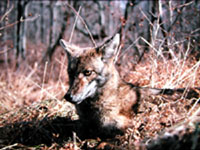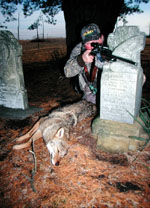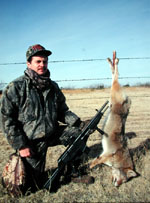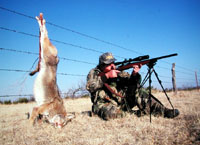
|
Features
|
|
|
|
Books
|
|
|
|
Fun & Games
|
|
|
|
Contact Us
|
|
|
John's Journal... Entry 143, Day 3
SUNTANS AND COYOTES
Brad Harris On Coyote Calling When You Don't Know How And Decoys
 EDITOR'S
NOTE: If you hunt coyotes at this time of year, not only will you
get a suntan instead of frostbite, but the tactics you use will change.
Because you'll deal with older animals, you can use territorial calls
and pup calls along with distress calls. Here's what three of the nation's
leading coyote hunters say about the techniques they use to take the song
dogs during the long, hot days of summer. The director of public relations
for Lohman's Manufacturing, a division of Outland Sports, in Neosho, Missouri,
Brad Harris has called and hunted coyotes for many years.
EDITOR'S
NOTE: If you hunt coyotes at this time of year, not only will you
get a suntan instead of frostbite, but the tactics you use will change.
Because you'll deal with older animals, you can use territorial calls
and pup calls along with distress calls. Here's what three of the nation's
leading coyote hunters say about the techniques they use to take the song
dogs during the long, hot days of summer. The director of public relations
for Lohman's Manufacturing, a division of Outland Sports, in Neosho, Missouri,
Brad Harris has called and hunted coyotes for many years.
 You
won't find calling coyotes nearly as difficult as most newcomers to the
sport may believe. But to give the first-time coyote hunter more confidence
in his ability to hunt, call and take coyotes, Lohman's Manufacturing
has developed a new electronic caller, the Model 2000 Wildlife Calling
System. "For years, many sportsmen have believed the coyote is invincible,"
Harris mentioned. "Those same people once thought turkeys were impossible
to call. So, I'm convinced that once a hunter uses an electronic caller
and sees that he can in fact call in and take coyotes, then he'll be more
likely to use the other kind of callers available on the market. I believe
that using decoys drastically will increase the number of coyotes you
take, especially during the summer months."
You
won't find calling coyotes nearly as difficult as most newcomers to the
sport may believe. But to give the first-time coyote hunter more confidence
in his ability to hunt, call and take coyotes, Lohman's Manufacturing
has developed a new electronic caller, the Model 2000 Wildlife Calling
System. "For years, many sportsmen have believed the coyote is invincible,"
Harris mentioned. "Those same people once thought turkeys were impossible
to call. So, I'm convinced that once a hunter uses an electronic caller
and sees that he can in fact call in and take coyotes, then he'll be more
likely to use the other kind of callers available on the market. I believe
that using decoys drastically will increase the number of coyotes you
take, especially during the summer months."
 Harris
considers decoys extremely effective when you hunt areas where someone
has called to the coyotes there before. "When you can use some type of
decoy to convince the coyotes that he sees what he's been hearing, you're
much more likely to bring him in to where you want him to come." Harris
places a coyote tail on a little stick, ties a piece of monofilament fishing
line to the stick and throws the stick over a tree limb. Then by pulling
the string, he makes the coyote tail pop up and down in the grass like
a coyote pouncing on a rabbit or a bird. "When an older coyote comes in
that may have been called to before and hears some squeaking and calling
but can't see anything, he'll be suspicious," Harris said. "But if he
can see a coyote's tail, some rabbit fur or a decoy like the Rigor Rabbit,
he'll come in on the run. For the most success with using a decoy, put
the decoy where the coyote can see it. Also, a new technique that we're
trying, particularly in the summer, is to use a fawn distress call and
a fawn decoy for coyotes."
Harris
considers decoys extremely effective when you hunt areas where someone
has called to the coyotes there before. "When you can use some type of
decoy to convince the coyotes that he sees what he's been hearing, you're
much more likely to bring him in to where you want him to come." Harris
places a coyote tail on a little stick, ties a piece of monofilament fishing
line to the stick and throws the stick over a tree limb. Then by pulling
the string, he makes the coyote tail pop up and down in the grass like
a coyote pouncing on a rabbit or a bird. "When an older coyote comes in
that may have been called to before and hears some squeaking and calling
but can't see anything, he'll be suspicious," Harris said. "But if he
can see a coyote's tail, some rabbit fur or a decoy like the Rigor Rabbit,
he'll come in on the run. For the most success with using a decoy, put
the decoy where the coyote can see it. Also, a new technique that we're
trying, particularly in the summer, is to use a fawn distress call and
a fawn decoy for coyotes."
 When
Harris was questioned about what would happen when does came running in
to that fawn distress call, he explained that, "Does help decoy the coyotes
even better. Because with the does running toward the decoy and the sound,
you add more realism to the scene you're trying to create." To paint a
more realistic picture in the coyote's mind, Harris suggests you use some
type of deer urine with a fawn decoy and rabbit or fox urine with a rabbit
decoy. By using urine with your decoy, you appeal to the coyote's senses
of sight, hearing and smell to lure him to within gun range. Harris names
the shotgun as the weapon of choice for most hunters to hunt thick cover
in the summer months. "I like to shoot a 12-gauge and No. 4 buckshot because
it will penetrate the thick grass and still take the coyotes," Harris
explained. "In the summer months, you'll get closer shots than in the
winter months."
When
Harris was questioned about what would happen when does came running in
to that fawn distress call, he explained that, "Does help decoy the coyotes
even better. Because with the does running toward the decoy and the sound,
you add more realism to the scene you're trying to create." To paint a
more realistic picture in the coyote's mind, Harris suggests you use some
type of deer urine with a fawn decoy and rabbit or fox urine with a rabbit
decoy. By using urine with your decoy, you appeal to the coyote's senses
of sight, hearing and smell to lure him to within gun range. Harris names
the shotgun as the weapon of choice for most hunters to hunt thick cover
in the summer months. "I like to shoot a 12-gauge and No. 4 buckshot because
it will penetrate the thick grass and still take the coyotes," Harris
explained. "In the summer months, you'll get closer shots than in the
winter months."
TOMORROW: DAVID HALE ON COYOTE CALLING
Check back each day this week for more SUNTANS AND COYOTES...
Day 1 - Brad Harris On Taking
Coyotes
Day 2 - Brad Harris On Scent Control
Day 3 - Brad Harris On Coyote Calling When
You Don't Know How And Decoys
Day 4 - David Hale On Coyote Calling
Day 5 - Ken Allein On Coyote Callings